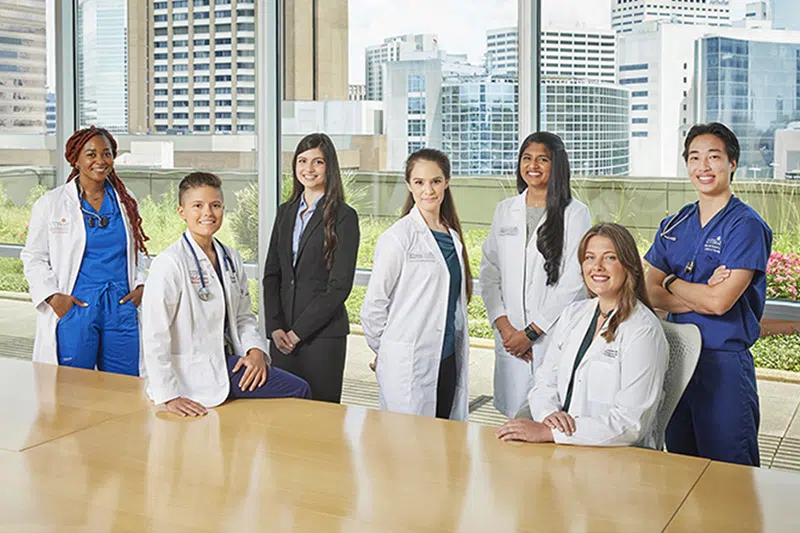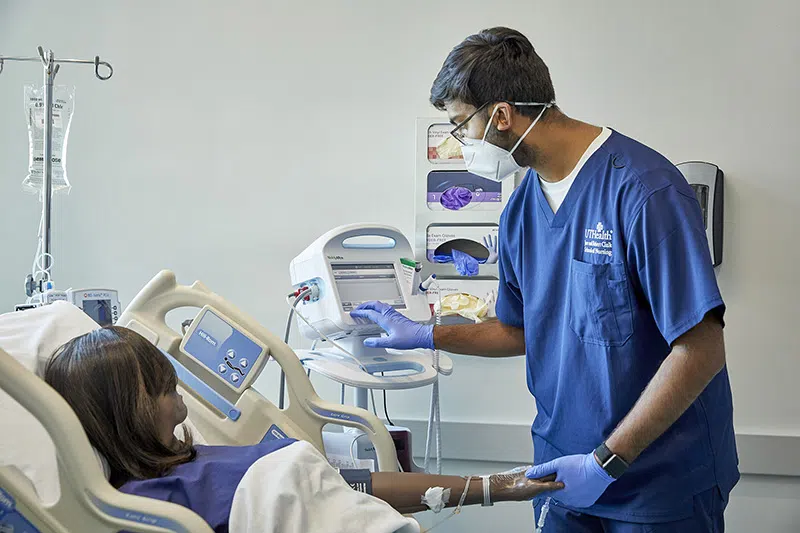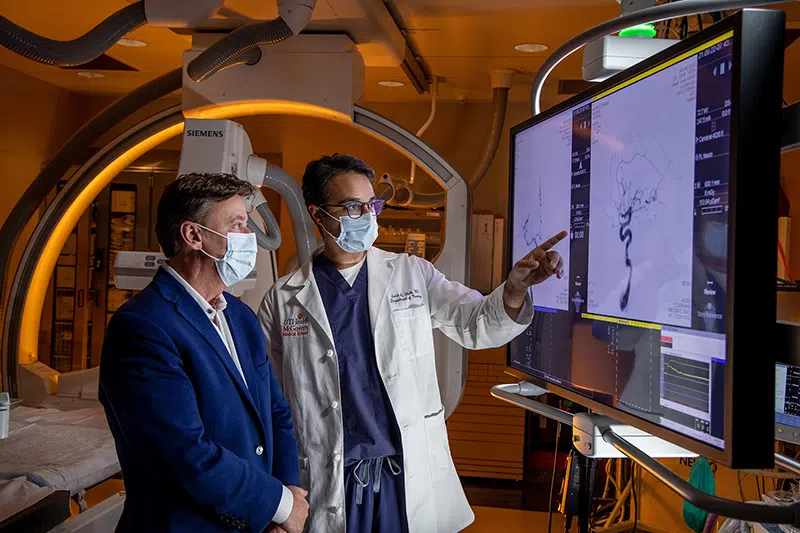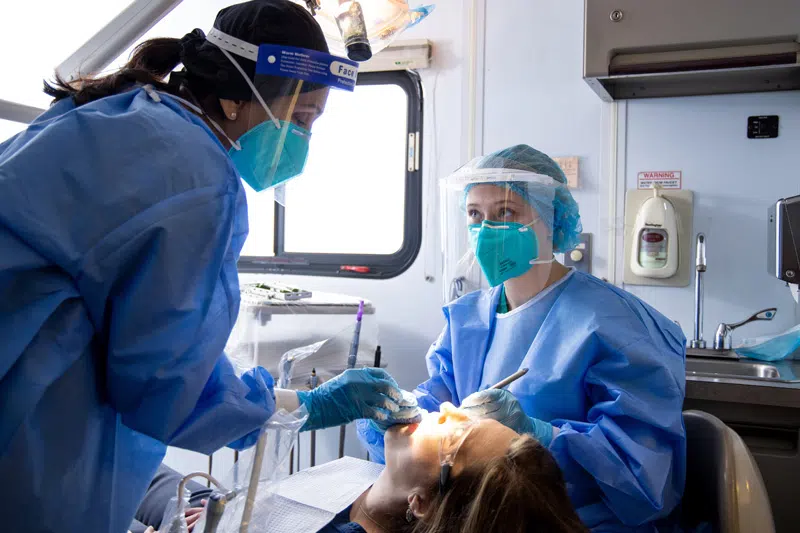Laboratory safety surveys are conducted on a routine basis in all of the biomedical research and clinical laboratories. The focus of the surveys is to ensure compliance with a number of general safety, fire safety, chemical safety, physical safety compliance issues. The Environmental Health and Safety (EH&S) department takes a proactive approach to compliance problems found in the laboratories and in most cases facilitates the corrective action process. Follow-ups are conducted periodically to ensure that corrective actions have taken place. The following outlines the basic laboratory survey criteria and references the specific.
Laboratory Safety Survey Criteria
Emergency phone numbers posted and clearly visible
Each laboratory should have posted near the phone numbers to call in the event of an emergency. In addition to numbers for chemical spill, radiation spill, fire and medical emergency, there should also be included name of responsible person (PI) along with office and home phone. A list of campus emergency phone numbers can be found on page ix of the Laboratory Safety flip chart. [OSHA 29CFR 1910.38 (a) (2) (v); Lab Safety Manual, First Edition p. 2-34; Prudent Practices in the Laboratory p. 87]
Appropriate warning signs posted
NFPA 704- diamond posted outside the laboratory for use by firefighters in an emergency situation only. Radioactivity work areas, laboratories and containers of radioactive materials must be posted with appropriate warning signs. [Radiation safety manual] Areas where human blood or other potentially infectious materials are stored or used must bear the universal biohazard symbol. Researchers working with or storing biosafety level 2 or higher organisms should also utilize t he universal biohazard warning. Appropriate locations for biohazard signs include laboratory entrance, incubator, refrigerator, and waste containers. [OSHA 29CFR 1910.1030 (g) (1) (i); Biosafety in Microbiological and Biomedical Laboratories p. 14, 20]
All relevant postings present
These include the Texas Hazard Communication notice to employees, Texas Regulations for Control of Radiation notice to employees, universal precautions posting, spills of hazardous materials, and emergency preparedness.
No food or drink rule observed
Food and drink brought into areas of chemical or radiological use can easily become contaminated by these hazards. Airborne particulates can settle on exposed food, eating surfaces or utensils. Even though work surface contamination may not be readily apparent, it can adhere to hands and then be transferred to food items. Upon ingestion these harmful substances will be carried into t he body, increasing the opportunity for toxic effects. [OSHA 29CFR 1910.141 (g) (2), (g) (4)]
All applicable binders/manuals available
Safety manuals available (Lab Safety manual, Disposal Guide, Radioactive Material User Guide) Every laboratory using hazardous chemicals, radioactive, or biological hazards must have a copy of the respective Laboratory Safety binder/manual in the lab or otherwise readily available. Thoroughly review all applicable safety manuals with laboratory staff. [OSHA 29CFR 1910.1450 (e) (2)]
Ventilation negative to hallway
The primary objective in controlling occupational exposures is t o prevent contamination of the work atmosphere. This shall be achieved first by use of a chemical fume hood, or other enclosure. The second way in which this achieved is by making sure the ventilation is negative to the hallway (airflow into the laboratory) [OSHA 29CFR 1910.1450 Appendix A]
Egress pathways unobstructed
It is best if every laboratory have two unobstructed means of egress available at all times. An accident such as a fire or large chemical spill occurring near the main lab entrance inactivates that exit. In such an event a secondary means of egress (such as into an adjoining laboratory) can be used to safely evacuate the lab. To ensure the availability of an exit in the event of an emergency it is important that doors can be opened without undue burden (unlocked), and that there are no obstructions that might hinder escape such as carts or furniture blocking the door. [OSHA 29CFR 1910. 37 (f) (3); Prudent Practices in the Laboratory p. 84]
Fire extinguisher charged and inspected
Fire extinguisher should be inspected for broken seals, damage, and low gauge pressure (depending on type of extinguisher). Proper mounting of the extinguisher and its ready accessibility should also be checked. [Prudent Practices in the Laboratory p.137]
Access to electrical panel and gas line(s)
Access to electrical and gas lines shall be maintained in an orderly fashion and all workers shall know the location and operation of power shutoffs for areas in which they work. [Prudent Practices in the Laboratory p. 112]
Bunsen burner tubing free of defects
Leakage or escape of flammable gases can produce an explosive atmosphere. Ensure that all Bunsen burner tubing is free of defects such as kinks, cracks, multiple connections, etc.
Electrical cords in good condition
Any break in t he integrity of an electrical cord's insulation can allow moisture to seep in or the conductor to contact metal with the possibility of painful shock. All frayed or damaged cords must be completely replaced before the equipment is allowed back into use, or the item disposed of. Replacement plugs must fully encase the primary and secondary insulation. [OSHA 29CFR 1910.303 (c); Prudent Practices in the Laboratory p. 110]
Heat sources separated from combustibles
One of the easiest methods of fire risk reduction is to remove ignition sources from a flammable system (fuel + oxygen + ignition source). Ignition sources include electrical outlets, lighting fixtures, switches, exposed machinery components, as well as open flame. Flammable solvents should be used inside a chemical fume hood so vapors will be prevented from reaching flammable proportions. In the special case of a flammable solvent being heated (as in a distillation) it is important that all ignition sources (electrical outlets, Variac controllers, outlet strips) be located to the outside of the hood. [NFPA 45 9-1.2.1, 9-2.3.3; Prudent Practices in the Laboratory p. 95-96]
No visible circuit overloading
Multi-outlet adapters and octopus extenders can overload and short-circuit. Power strips with an integrated circuit breaker are designed to handle the excess current load and can be safety used when additional outlets are needed. Extension cords used on a temporary basis only, not as a permanent source of electricity. Extension cords can be used for short duration, temporary purposes only. If additional outlets are needed on a long tern or routine basis then they must be permanently installed by a qualified person. [OSHA 29CFR 1910.305 (g)(1)(iii)(A); Prudent Practices in the Laboratory p. 110]
Appropriate clearance to ceiling
It is recommended that there is to be an 18" clearance to the ceiling.
Compressed gas cylinders secured
Compressed gas cylinders are under great pressures, often exceeding 2000 pounds per square inch or 136 atmospheres. To prevent the accidental and uncontrolled release of energy it is important to protect cylinders from toppling over and rupturing the valve stem. All compressed gas cylinders, including lecture bottles, "empty" cylinders, and cylinders in transit, must be secured in racks, clamping devices, holders, stands, or other protective structure. [Prudent Practices in the Laboratory p. 122]
Protective equipment & clothing available
Chemical resistant gloves available and worn during procedures. To choose the best glove for a particular operation one must weigh the ability of the glove material to resist permeation and degradation by the chemicals in use against the dexterity needed to conduct the experimental protocol. There is no single glove material universally resistant to all classes of chemicals; glove selection must be individualized for each experimental protocol. Eye protection available and worn during procedures. The eyes are particularly sensitive to chemical or physical insult and should be protected at all times against chemical splashes or sprays, flying particles, UV radiation and other hazards. Protective clothing available and worn during procedures (lab coat, apron, etc.) Lab coats not only protect street clothing from being soiled, they also provide an additional layer of splash and burn protection and help protect family members by reducing take-home toxins [OSHA 29CFR 1910.132 (a); Prudent Practices in the Laboratory p. 131-132]
Guards for mechanical hazards in place
Some common pieces of lab equipment present physical hazards due to rotating parts, nip points or other mechanical action. Particularly prevalent in the lab are vacuum pumps that have had their belt guards removed. To prevent injury due to entrapment of hair, clothing or other items it is necessary that these areas remain guarded. Any piece of equipment with a detached, disengaged or inoperable guard must be prominently tagged and removed from service. [OSHA 29CFR 1910.212; Prudent Practices in the Laboratory p. 120]
Electrical equipment properly grounded
Equipment supplied with a grounded plug require attachment to a ground source. Removal of the grounding prong interferes with this electrical safety feature and can result in shock or electrocution. [OSHA 29CFR 1910.334 a)(3)(ii)]
Biological Agents
Biohazards are a concern in laboratories in which microorganisms or material contaminated with them is handled. These hazards are usually present in clinical and infectious disease research laboratories, but may also be present in any laboratory in which bodily fluids or tissues of humans or animal origin are handled. Identify what bioagents are being used, is the agent infectious, does the research include the use of rDNA. Identify any animals being used in the research.
Biosafety cabinets certified within past year
Biosafety cabinet certification when installed or moved, and annually thereafter. The biosafety cabinet's (BSC) ability to filter out microscopic particles relies on the seals being intact and the HEPA filter free of micro tears or breaks that can easily occur during moving, instillation or careless handling. To ensure continued proper operation, each BSC should be tested and certified at least annually. [CDC/NIH Primary Containment for Biohazards: Selection, Installation and Use of Biological Safety Cabinets p. 29; NRC Biosafety in the Laboratory p. 26]
Chemicals present
Identify the types of chemicals being used with in the laboratory, are they inventory required, darkroom chemicals, salts, buffers, media, cleaners etc.
Air flow in chemical fume hood adequate
Hazardous chemicals that are flammable, volatile, or gases should be manipulated inside a properly functioning chemical fume hood. Optimum height is the sash height at which air flow is maximized without creating turbulence, generally between 60 and 150 LFPM. A yellow sticker placed on the hood face indicates the most recently recommended sash height. Hoods can malfunction at any time without warning. It is important to confirm hood operation before each work session. Check the air flow gauge if so equipped. In the absence of a gauge one can tape an inch wide strip of tissue to the lower corner of the sash. Air flow can be visually assessed by noting that the tissue is pulled gently into the hood. [OSHA 29CFR 1910.1450 (e) (3) (iii); Prudent Practices in the Laboratory p. 179-180]
Chemical fume hood sash kept closed
In order to promote safety and conserve energy, the chemical fume hood sash must be closed when not in use. If a reminder sticker is needed, please contact Chemical Safety at 713-500-5832.
Controlled substances secured
Controlled substances must be secured in accordance with TDH regulations include the following criteria:
Establishing adequate security to prevent unauthorized access to controlled substances and dangerous drugs, including a preliminary security inspection (contact UTPD for assistance).
Not allowing any individual access to controlled substances and dangerous drugs storage areas except those authorized for efficient operations during the course of business activities.
Storing controlled substances and dangerous drugs listed in schedules I, II, III, IV, and V in a securely locked substantially constructed cabinet or security cabinet.
Absence of old or potentially explosive chemicals
Out-dated, expired, unknown chemicals promptly disposed of Many materials, as they age, become unstable, possibly forming explosive byproducts or undergoing rapid and violent decomposition. Other materials simply loose purity as contaminants are introduced or residues form. Chemicals that may no longer be used, that are of questionable purity, or that are past their expiration dates should be removed from the lab. [Prudent Practices in the Laboratory p. 70]
Chemicals properly labeled
Manufacturers are required to label every chemical container with hazard information that includes chemical name, physical and health hazard information, and name of manufacturer. These labels relay valuable information that can assist in hazard evaluation and control, and cannot be removed or defaced from the original container unless the contents have been altered or removed. Secondary containers that will remain in use for a period of time (storage vials, squirt bottles) should bear an abbreviated label that includes chemical name and hazard warning words such as flammable, caustic, sensitizer, carcinogen, absorbed through the skin, etc. [OSHA 29CFR 1910.1450 (h) (i)]
Proper segregation of chemicals
Storage of chemicals as a general group alphabetically is not recommended as it may place incompatible materials together on a shelf. Instead, separate chemicals into organic and inorganic families and then into related and compatible groups. Suggested chemical storage schemes and list s of compatibility's can be found in a number of lab safety resources available from EHS. A quick and very general rule of thumb is to separate acids from bases, flammables from oxidizers, and reactives from air or water. [Prudent Practices in the Laboratory p. 72-73]
Hazardous liquid chemicals stored below eye level
Every chemical should have assigned to it a definite storage place and should be returned to that place after each use. Do not store materials on top of high cabinets where they will be hard to reach and see. [Prudent Practices in the Laboratory p. 72-73]
Chemical storage acceptable
Storing chemicals in stockrooms and laboratories requires consideration of a number of health and safety factors. Avoid storing chemicals in laboratory hoods, except for those chemicals being used currently. Store flammable liquids in an approved flammable storage cabinet. Observe all precautions regarding the storage of incompatible chemicals. Do not expose stored chemicals to heat or direct sunlight. Do not store glass bottles on the floor unless it is inside secondary containment provided by UTHealth - Environmental Health and Safety [Prudent Practices in the Laboratory p. 72-73]
Flammables not stored in regular refrigerator
A number of common solvents have flashpoints close to or below the temperature at which most refrigerators operate (around 38°F or 33°C). Flammable solvents evaporate rapidly even at lowered temperatures, so they can quickly reach equilibrium inside the small, well-sealed space of a refrigerator. When flammable vapors reach the LEL sources of ignition inside a conventional refrigerator such as the thermostat, interior light, defroster, compressor, or fan can set off an explosion. Flammable liquids that must be stored at reduced temperature require a specially designed refrigerator, termed a "flammable material storage refrigerator," where ignition sources are isolated from the inside space. [Prudent Practices in the Laboratory p. 74, 113]
Chemical Waste
Ensure that all chemical waste containers are kept closed and marked "Hazardous Waste" or equivalent. Outdated, expired, unknown chemicals promptly disposed of. Many materials, as they age, become unstable, possibly forming explosive byproducts or undergoing rapid and violent decompositions. Other materials simply lose purity as contaminants are introduced or residues form. Chemicals that may no longer be used, that are of questionable purity, or that are past their expiration dates should be removed from the lab. [Prudent Practices in the Laboratory p. 70]
Biological Waste
Common methods for biological waste include disinfecting , autoclaving, and for liquid disposal in the sanitary sewer. Make sure that the container is properly labeled, it is decontaminated before disposal, and note the methods of disposal for each liquid and solid waste. Observe that biohazard waste is stored in secondary containment. [Prudent Practices in the Laboratory p. 151]
Appropriate sharps container in use
Contaminated sharps include needles, scalpels, broken capillary tubes, exposed dental wires, and broken glass if contaminated with human blood or other potentially infectious material. These items must be collected in a sharps box or other puncture resistant container that is color coded or labeled with the universal biohazard symbol. [OSHA 29CFR 1910.1030 (b), (d) (2) (viii)]










